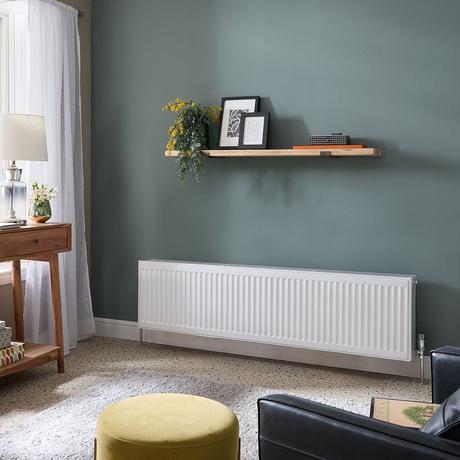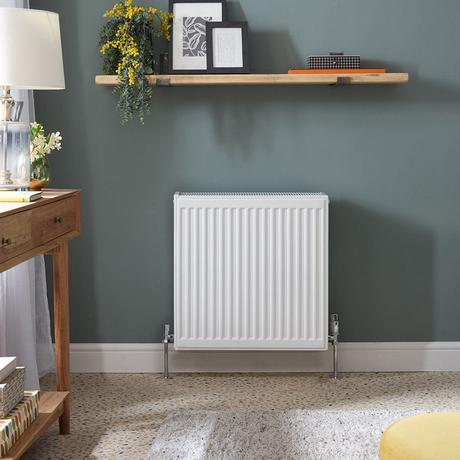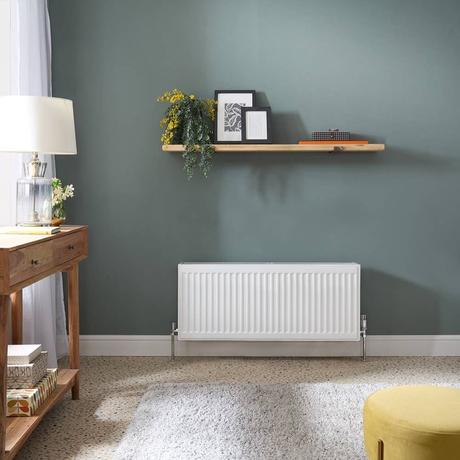What we’ll cover…
• What are Type 33 radiators?
• The advantages Type 33 radiators provide for a home
• Which heating systems to team with Type 33 radiators
• An overview of various compatible heating systems with pros and cons
• How to decide on the best heating system to work alongside Type 33 radiators
• The wide range of triple panel radiators from BestHeating
How to choose the right heating system for triple panel radiators
For an efficient overall home heating performance, it is key to make sure you have the right heating system in place to get the best out of your radiators or alternate devices. Type 33 radiators, or triple panel radiators, are an excellent option for many homes on account of their relatively low cost, high heat output and strong efficiency levels.
But which heating systems work best alongside them? This article will explore the variety of heating systems that Type 33 radiators are operational alongside, so you can come to an informed decision.

What are Type 33 radiators?
Type 33 radiators are convector radiators which feature three convectors in addition to three panels. Their design lends itself to the projection of the highest possible heat output, which makes them a great option for larger houses or properties situated in colder climates. Most commonly, triple panel radiators are used alongside a central heating system, and renowned for their efficiency and effectiveness at the fast heating of spaces.
Advantages of Type 33 radiators
- Impressive heat output – A profile incorporating triple panels and triple convectors guarantees an impressive heat output that will quickly heat up large spaces.
- Energy efficiency levels – Type 33 radiators are designed to offer supreme heat retention attributes, in turn lowering energy consumption.
- Versatility – Triple panel radiators are suitable for pairing with a wide range of heating systems, ensuring they are a flexible option for homeowners.
What to consider when selecting a heating system
Home layout and size
The layout and size of your home will have a sizeable impact on which type of heating system you should opt for. Bigger households might need a more robust system in comparison with smaller properties, which could instead profit from more compact solutions.
Location and climate
The local climate that a home is situated within plays a vital role in identifying the best heating system to suit your specific requirements. Geographical spots that experience harsh winter conditions will need a more powerful system in contrast with places that typically enjoy milder months even towards the end of the year.
Energy efficiency As spiralling energy costs and environmental concerns continue to be a hot topic, energy efficiency levels are a top priority as it pertains to home heating. Choose a heating system that operates with the utmost efficiency to trim energy bills and decrease your carbon footprint.
Different central heating systems
Central heating system overview
Central heating systems offer the most common means for efficiently heating a home, distributing warmth via a central source such as a boiler. The heat is transferred through a pipe network to reach radiators or alternate heat sources such as heated towel rails all around the house.
Type 33 radiator compatibility
Type 33 radiators are greatly compatible alongside central heating systems, delivering a consistent and efficient performance all throughout the home.

Gas Boilers
Gas boilers heat up water by burning natural gas. This hot water is then transported through radiators or alternate heating solutions to warm the home.
Pros:
- Cost-effective and efficient
- Widely available and reliable
Cons:
- Require a gas supply
- Need regular maintenance
- Government schemes favour the phasing out of this type of heating system*
*See our article, The UK gas boiler ban: what you need to know
Electric boilers
With electric boilers, unsurprisingly electricity is used to heat up the water, offering a viable alternative to gas boilers, especially so in homes that don’t have a gas supply.
Pros:
- Simple installation
- Low maintenance
Cons:
- More expensive to run
- Reliant upon electrical supply
Oil boilers
Oil boilers utilise oil for the heating of water, which is then transported to radiators or other hot water systems. They make for an ideal addition to households which aren’t connected to the gas grid.
Pros:
- An effective option for homes in remote locations
- Excellent energy efficiency levels
Cons:
- Volatile oil costs
- A typically bulky storage tank is necessary
Heat pumps
Air source and ground source heat pump options
Heat pumps extract energy either from air or ground sources, transforming it into heat for your home. They are an extremely efficient and environmentally friendly option. Find out more in our full article, The ultimate guide to air source heat pumps.
Pros:
- Extremely energy efficient
- Renewable energy source
- Could be eligible for financial support with purchase cost
Cons:
- Expensive initial purchase price (could be offset with government help)
- Additional insulation might be required
Solar heating solutions
Solar heating solutions utilise solar panels to derive energy from natural sunlight, which is then used for the heating of water or for space heating purposes. They are able to integrate with Type 33 radiators, usually as part of a hybrid system, to improve efficiency.
Pros:
- A renewable energy source
- Lower energy bills
Cons:
- Dependent on weather conditions
- Expensive initial purchase cost
Biomass boilers
For biomass boilers, organic materials such as wood pellets are burned for the production of heat, providing a viable and sustainable alternative option to fossil fuels.
Pros:
- Renewable energy option
- Can work very efficiently
Cons:
- Necessitates fuel storage
- Regular maintenance required
Hybrid heating systems
Hybrid heating systems represent a combination of two or more heating technologies, like a gas boiler and a heat pump for instance, to maximise reliability and energy efficiency.
Pros:
- Very efficient operation that optimizes energy usage
- Flexibility to adapt to various energy sources
- Excellent reliability on account of one or more backup heating sources
Cons:
- High initial purchase price
- Potentially costly maintenance, as more than one system requires servicing
- Compatibility may be an issue with older homes, where retrofitting could be necessary

Underfloor heating
An underfloor heating system will evenly distribute heat across the floor, offering a comfortable and efficient means of home heating. Underfloor heating can be teamed with Type 33 radiators to improve the efficiency of your overall heating setup.
Pros:
- Level distribution of heat
- Efficient operation
- Provide comfortable underfoot conditions
Cons:
- Expensive installation costs (might require significant disruption to existing home layout)
- Take longer to heat up
Radiant heating systems
A radiant heating system will deliver heat directly to the floor or the wall or ceiling panels, providing a comfortable and efficient heating method. Radiant heating options are another type that can operate in cohesion with triple panel radiators for an efficient and balanced home heating solution.
Pros:
- Energy efficient operation
- Even distribution of heat
Cons:
- More expensive initial installation cost
- Proper insulation a necessity
Hydronic heating systems
Hydronic heating systems use water for the transportation of heat. This is transferred via a pipe network that will connect to radiators (including Type 33) or underfloor heating.
Pros:
- Reliable and efficient
- Deliver a consistent level of heat
Cons:
- Higher installation costs
- Boiler requirement
So, which heating system should I choose for Type 33 radiators?
Selecting the ideal heating system for your Type 33 radiators means taking a wide array of factors into consideration, such as the energy efficiency, climate and size of the home.
From boilers of the gas and electric variety, to air and ground source heat pumps, biomass boilers and other green solutions, there’s an impressive choice of options to suit all sorts of different preferences and requirements.
Our brief overview of multiple system solutions, along with their advantages and drawbacks, should offer an indication as to which heating option will best meet your specific needs and wants. And ultimately, you can reach an informed decision to keep your home warm and comfortable with Type 33 radiators.
Buy Type 33 radiators online with BestHeating
Once you have landed on the perfect heating system, you can select the ideal Type 33 radiators to complete the setup.
BestHeating supply a supreme range of triple panel radiators in all sorts of attractive designs to match up with virtually any interior design scheme.
Shop Type 33 radiators online today, or get in touch with us for any further advice or help surrounding the best option for your household. You can reach us in the comments section below, or contact us through Instagram, Facebook or X.
Frequently Asked Questions
bDo you need to make any special considerations for triple panel radiators?
Certain special considerations might have to be made for triple panel radiators, or Type 33 radiators as they are also known.
The existing heating system is one example where adjustments might be required. Triple panel radiators are larger and heavier than many other styles, so an alteration or replacement might be needed to support this. Essentially, you would need to check that your boiler is compatible with the Type 33 radiator before investment, as a more powerful contemporary version could be required to deliver the proper performance level.
The triple panel radiator material might also play a part. Stainless steel is usually used in their construction, so you will need to think about the impact this has on heat retention capabilities. And be sure to choose the correct size to prevent overheating or underheating from day to day.
Aside from this, there is the possibility that bleeding the radiators will be required as general maintenance from time to time. Plus, the no-frills aesthetic of typical triple panel radiators might not be suited to everyone’s taste.
To find out more, explore our blog, Boost heating efficiency: Are Type 33 radiators worth it?
Share View FAQ Page bHow do triple panel radiators improve efficiency?
Triple panel radiators, also known as Type 33 radiators, can offer an improved level of energy efficiency due to their three-panel design and larger surface area than other types.
What’s more, triple panel radiators also feature convector fins that enable better air circulation and quicker heat distribution throughout the room they are situated in.
Triple panel or Type 33 radiators can essentially heat up their space faster than counterparts with less panels due to these attributes that aid enhanced efficiency and circulation. For further information, browse our blog, Boost heating efficiency: Are Type 33 radiators worth it?
Share View FAQ Page bWhat is a triple panel radiator?
A triple panel radiator, also referred to as a Type 33 radiator, incorporates a three-panel profile along with convector fins.
The design of triple panel radiators ensures that these Type 33 radiators can operate with an excellent level of energy efficiency, with multiple panels requiring a bigger surface area for a simple transfer of heat. The accompanying convector fins assist with enhanced air circulation and better heat distribution in turn.
All in all, triple panel radiators can heat up a room quicker than other components with less panels. For a deeper insight, explore our blog, Boost heating efficiency: Are Type 33 radiators worth it?
Share View FAQ Page
